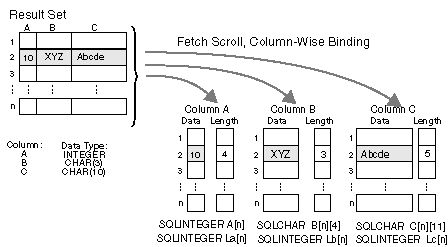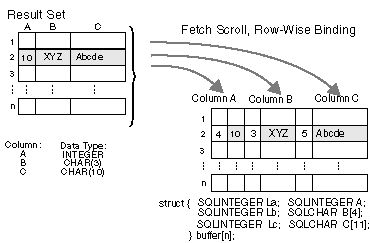One of the most common tasks performed
by an application is to issue a query statement, and then fetch each
row of the result set into application variables that have been bound
by using the SQLBindCol() function. If
the application requires that each column or each row of a result
set be stored in an array, each fetch must be followed by either a
data copy operation or a new set of SQLBindCol() calls
to assign new storage areas for the next fetch.
Alternatively, applications can eliminate the resource usage of
extra data copies or extra SQLBindCol() calls by
retrieving multiple rows of data (called a rowset) at one time into
an array.
Note: A third method of reducing resource usage, which can be used
on its own or with arrays, is to specify a binding offset. Rather
than re-binding each time, an offset can be used to specify new buffer
and length/indicator addresses which will be used in a subsequent
call to SQLFetch() or SQLFetchScroll().
This can only be used with row offset binding.
When retrieving a result set into an array, SQLBindCol() is
also used to assign storage for application array variables. By default,
the binding of rows is in column-wise fashion: this is similar to
using SQLBindParameter() to bind arrays of input
parameter values. Figure 1 is a logical
view of column-wise binding.
Figure 1. Column-wise binding
The application can also do row-wise binding which associates an
entire row of the result set with a structure. In this case the rowset
is retrieved into an array of structures, each of which holds the
data in one row and the associated length fields. Figure 2 gives a pictorial view of row-wise
binding.
Figure 2. Row-wise binding

